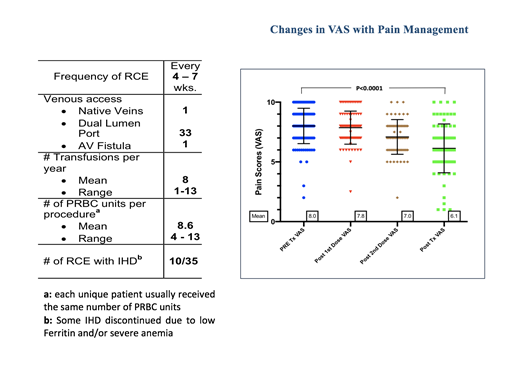Purpose: Therapeutic erythrocytapheresis, known also as automated red blood cell exchange transfusion (RBC exchange), is standard of care for patients with sickle cell disease (SCD) presenting with severe complications and for primary prevention of CNS events in those with increased risks. There is limited data on the framework and experience of performing this procedure in a large adult population and even less on challenges and outcomes. Here, we present demographic and statistical data highlighting characteristics of the chronic exchange transfusion program at a comprehensive and multidisciplinary adult SCD center.
Methods: Data were collected from adults (18 years and older) with a diagnosis of SCD that were receiving blood transfusions in the outpatient treatment facility from September 1st, 2017 to August 31st, 2018. Data gathered included age, gender, procedure indications and frequency, hemoglobin S percentage (Hb S%), target pre and post Hb S%, ferritin trend, and type of intravascular device used for procedure. Three hundred and forty-four (344) episodes of transfusions, were performed in 52 unique patients, corresponding to 21 % of the unique patients treated at our center during that period. Two hundred and sixty-two (262) of the transfusion procedures were RBC exchanges. These RBC exchanges were performed in 35 (14%) of the unique patients. Since a sizable proportion of our patients received pain treatment during RBC exchange, we explored how the pain visual analog score (VAS) changed while undergoing pain treatment during RBC exchange and in relation to multiple opiate doses. Descriptive and basic statistical analysis were performed on the data obtained for those receiving RBC exchange alone or in combination with pain management.
Results: Thirty-five unique patients underwent RBC exchange during the study period. All but two (2) patients had the procedure via an implanted dual lumen Vortex port, one (1) by an arteriovenous fistula and one (1) via his native veins. Most of the RBC exchanges were performed as part of a chronic transfusion program for one of the following indications: primary prevention of stroke; secondary prevention of stroke; recurrent acute chest syndrome (ACS); intractable pain; presence of multiple comorbidities including pulmonary hypertension, chronic kidney disease and intractable leg ulcers. One patient received RBC exchange in preparation for bone marrow transplant. The three (3) other patients that only received one (1) RBC exchange during that period were previously on exchange transfusion but discontinued the procedure due lack of venous access or benefit from the procedure. The frequency of RBC exchange varied depending of the patient's specific indication for the procedure and the ability to reach a target Hb S% goal of < 30%. The RBC exchange occurred in patients as frequently as every four (4) to seven (7) weeks. The number of transfusions per patient/year ranged from one (1) to thirteen (13) with a mean and median of eight (8). Number of RBC units used per procedure ranged from four (4) to thirteen (13) with a mean of eight (8.6), with each unique patient usually receiving the same amount. Twenty-three (66%) unique patients received, at least once, acute pain treatment - oral, intravenous, or a combination during RBC exchange. The mean change of VAS between presentation and end of the pain management period was 1.9 (p<0.0001).
Conclusion: Our data shows that therapeutic RBC exchange are performed on a regular basis on a small but significant subgroup of patients living with SCD and treated at a comprehensive SCD center. Intravenous opioid management of acute pain can be effectively performed while receiving RBC exchange which provides patients with multimodal interventions in the outpatient setting. The relationship between change in VAS and concurrent transfusion deserves further investigation. Although there are standard indications for RBC exchange, we and others use it for indications for which there is low level of evidence or no evidence of efficacy (i.e. leg ulcers). We found that there great variability on the frequency of the procedure, total number of RBC exchanges per year and number of RBC units used. Prospective studies are needed to better understand the short and long-term effects, complications and outcomes of chronic RBC exchange in adults living with SCD.
Kato:Bayer: Research Funding; Novartis, Global Blood Therapeutics: Consultancy, Research Funding. De Castro:Pfizer: Consultancy; Novartis: Membership on an entity's Board of Directors or advisory committees; Global Blood Therapeutics: Membership on an entity's Board of Directors or advisory committees.
Author notes
Asterisk with author names denotes non-ASH members.


